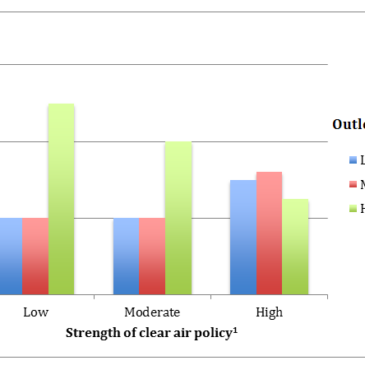Some research has found that young people smoke less if they have to travel further to buy tobacco products (Altman & Jackson, 1998). However, findings about the relationship between number of tobacco outlets in an area and youth smoking are mixed (Novak,Reardon, Raudenbush, & Buka, 2006). Today’s ASHES reviews a study that investigates if local tobacco policies (e.g., clean air laws) affect the relationship between tobacco outlet density and youth smoking (Lipperman-Kreda,Grube, & Friend, 2012).
Methods
- The researchers conducted a general household survey, interviewing 1,491 youth (mean age = 14.7 years) across 50 randomly distributed midsize California cities.
- Participants reported their frequency of cigarette smoking in the past year on a 7 point scale (“never” to “every day”).
- The researchers collected data about indoor and outdoor clean air laws in each city from various smoke policy databases, rating each city on the strength of those laws.
- The researchers collected data about tobacco outlet density (i.e., the number of tobacco-licensed retail stores) in each city from the State of California Board of Equalization data-files.
Results
- Multilevel regression analysis revealed the following results:
- Youth who lived in areas with many tobacco-licensed retail stores smoked more frequently.
- Across all cities, there was no relationship between the strength of clean air laws and participants’ smoking frequency.
- However, clean air policies did appear to influence the relationship between tobacco outlet density and youth smoking.
- As Figure 1 shows, in cities with relatively weak clean air laws, youth smoked more frequency in high tobacco outlet density areas. In areas with strong clean air laws, there was little relationship between tobacco outlet density and youth smoking.

Figure. The interaction effect of clean air policy strength and tobacco outlet density on smoking frequency (adapted from Lipperman-Kreda et al., 2012). Click image to enlarge.
Note: 1For purposes of the Figure, the researchers distinguished between low, moderate and high levels of clean air policy strength to have equal number of cities in each group; and three levels of outlet density: low (4.23 – 10.35 retail outlets per 10,000 persons), moderate (10.36 – 13.7) and high (13.88 – 20.29).
Limitations
- The study does not examine causality. It only presents the associations between the outlet density, tobacco policy and smoking frequency. For example it might be that cities with high levels of smokers demand more tobacco outlets, not that the outlets lead to more smoking.
- The study investigates a specific sample of California cities. The results might be different in smaller towns or larger cities.
- The study relies on self-reports of smoking behaviors.
Conclusion
The results of the study confirm the previous findings (Novak, et al., 2006) that the number of retail tobacco outlets in the area is positively related to the average frequency of youth smoking in the same area. The new finding, however, is that the importance of density is moderated by the local clean air policy. The density was less important for the cities with strong clean air policies. Therefore, the results suggest both the control over the number of tobacco outlets in the area and enforcement of the clean air policies as potential mediums for preventing youth smoking.
— Julia Braverman
References
Altman, D. G., & Jackson, C. (1998). Adolescent tobacco use and the social context. . In S. Schumaker, E. B. Schron, J. K. Ockene & W. L. McBee (Eds.), The handbook of health behavior change (pp. 305 – 329). New York: Springer.
Lipperman-Kreda, S., Grube, J. W., & Friend, K. B. (2012). Local tobacco policy and tobacco outlet density: associations with youth smoking. J Adolesc Health, 50(6), 547-552. doi: 10.1016/j.jadohealth.2011.08.015
Novak, S. P., Reardon, S. F., Raudenbush, S. W., & Buka, S. L. (2006). Retail tobacco outlet density and youth cigarette smoking: a propensity-modeling approach. Am J Public Health, 96(4), 670-676. doi: 10.2105/ajph.2004.061622
What do you think? Please use the comment link below to provide feedback on this article.




